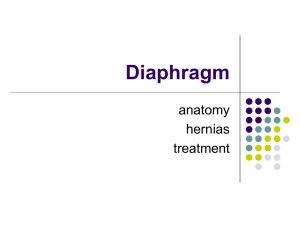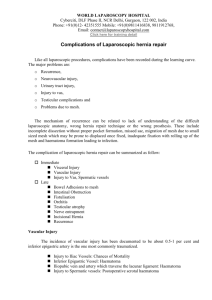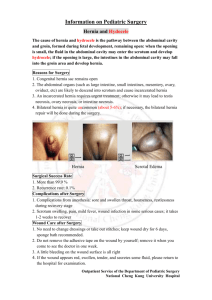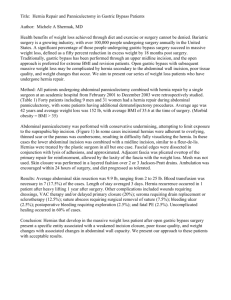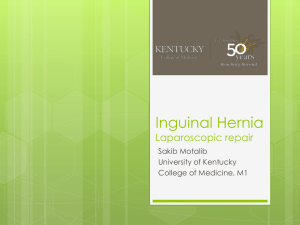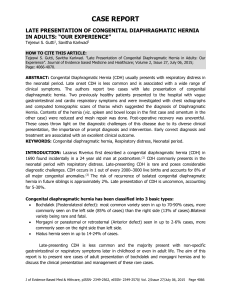Case Report
advertisement
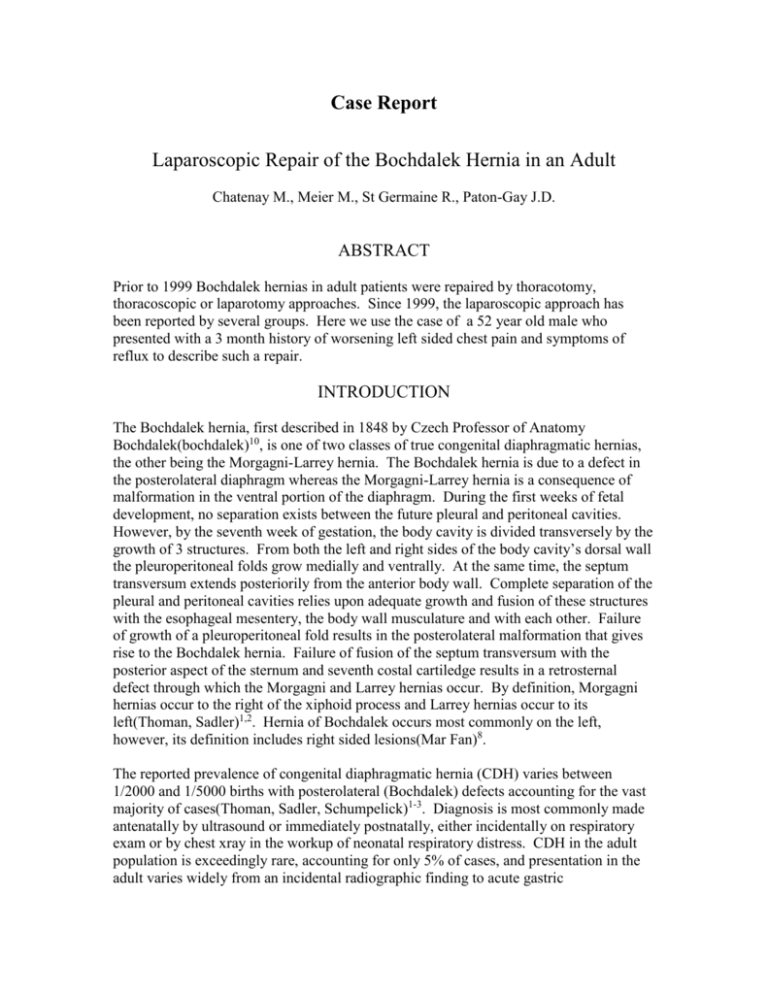
Case Report Laparoscopic Repair of the Bochdalek Hernia in an Adult Chatenay M., Meier M., St Germaine R., Paton-Gay J.D. ABSTRACT Prior to 1999 Bochdalek hernias in adult patients were repaired by thoracotomy, thoracoscopic or laparotomy approaches. Since 1999, the laparoscopic approach has been reported by several groups. Here we use the case of a 52 year old male who presented with a 3 month history of worsening left sided chest pain and symptoms of reflux to describe such a repair. INTRODUCTION The Bochdalek hernia, first described in 1848 by Czech Professor of Anatomy Bochdalek(bochdalek)10, is one of two classes of true congenital diaphragmatic hernias, the other being the Morgagni-Larrey hernia. The Bochdalek hernia is due to a defect in the posterolateral diaphragm whereas the Morgagni-Larrey hernia is a consequence of malformation in the ventral portion of the diaphragm. During the first weeks of fetal development, no separation exists between the future pleural and peritoneal cavities. However, by the seventh week of gestation, the body cavity is divided transversely by the growth of 3 structures. From both the left and right sides of the body cavity’s dorsal wall the pleuroperitoneal folds grow medially and ventrally. At the same time, the septum transversum extends posteriorily from the anterior body wall. Complete separation of the pleural and peritoneal cavities relies upon adequate growth and fusion of these structures with the esophageal mesentery, the body wall musculature and with each other. Failure of growth of a pleuroperitoneal fold results in the posterolateral malformation that gives rise to the Bochdalek hernia. Failure of fusion of the septum transversum with the posterior aspect of the sternum and seventh costal cartiledge results in a retrosternal defect through which the Morgagni and Larrey hernias occur. By definition, Morgagni hernias occur to the right of the xiphoid process and Larrey hernias occur to its left(Thoman, Sadler)1,2. Hernia of Bochdalek occurs most commonly on the left, however, its definition includes right sided lesions(Mar Fan)8. The reported prevalence of congenital diaphragmatic hernia (CDH) varies between 1/2000 and 1/5000 births with posterolateral (Bochdalek) defects accounting for the vast majority of cases(Thoman, Sadler, Schumpelick)1-3. Diagnosis is most commonly made antenatally by ultrasound or immediately postnatally, either incidentally on respiratory exam or by chest xray in the workup of neonatal respiratory distress. CDH in the adult population is exceedingly rare, accounting for only 5% of cases, and presentation in the adult varies widely from an incidental radiographic finding to acute gastric volvulus(Harinath)9. Patients may present with vague upper abdominal or chest pain of varying duration, frequency and intensity or symptoms of gastroesophageal reflux 1,38 (Thoman, Schumpelick, Richardson, Frantzides, Al-emadi, Rice, Mar Fan) Despite the varying severity of symptomatology, surgical repair is indicated in all symptomatic adult cases11(Taskin). Laparoscopic repair of a Morgagni hernia was first reported in 1992 by Kuster et al. The laparoscopic approach to the repair of Morgagni hernias was quickly adopted because of the shortened recovery period it afforded and numerous case reports describe the procedure1,4,12(Thoman, Richardson, Rau). However, it was not until 1999 that the first laparoscopic Bochdalek hernia repair was reported(Al-E madi). Still, very few case reports exist describing laparoscopic repair of the Bochdalek hernia. Herein, we describe the laparoscopic Bochdalek hernia repair in a patient presenting with symptoms of gastroesophageal reflux disease. CASE REPORT A 52 year old male was referred for surgical treatment of GERD. He described a 3.5 month history of retrosternal and left sided chest pain that radiated to his left shoulder and neck. The pain worsened with lying supine and occasionally woke the patient at night. In the mornings, he had noticed some odynophagia with both solids and liquids. He denied both exacerbation of the pain and increased shortness of breath with exertion. Over the same time period he had noticed increasing regurgitation of gastric contents without emesis. He had been treated with omeprazole 20 mg qd but noted little relief. Past medical history was significant for hypertension and the patient had no past surgical history. Physical exam was entirely unremarkable. In May of 2003, gastroscopy and esophageal manometry were undertaken and revealed only weak lower esophageal sphincter tone and reproduction of the patient’s symptoms with acid infusion. Chest x-ray demonstrated a left sided Bochdalek hernia. Augmented computed tomography further characterized the lesion as a hernia sac with transverse dimensions of 7.5 X 9.5 cm that extended to the level of the left inferior pulmonary vein. The gastric fundus was entirely contained within the hernia sac. The aperture in the posterior portion of the left hemidiaphragm measured between 2 and 3 cm in diameter. Laparoscopy was performed on July 7, 2003. The patient was placed in the lithotomy position and the procedure was done from between the patient’s legs. Pneumoperitoneum was established via a Hasson port just superior to the umbilicus. A 10 mm port was placed left of the xiphisternum beneath the costal margin and two 5 mm ports were placed in each mid clavicular line. A 10 mm port was placed in the left anterior axillary line beneath the costal margin and a 5 mm port was placed just left of the umbilicus. With the liver retracted, the stomach was grasped and reduced through the defect along with some attached greater omentum. The lesser omentum was then incised using electrocautery and the incision was carried superiorly to reveal the hernia sac. The diaphragmatic defect was identified lateral to the left crus and the hernia sac was circumsized from the rim of the aperture. The left inferior phrenic artery was very closely approximated to the left border of the defect and was transacted during excision of the hernia sac. Bleeding was controlled with 5 mm vascular clips and 2-0 Ethibond suture intracorporeally. Upon reduction of the hernia sac, the left inferior phrenic vessels were again encountered. They were clipped again with 10 mm vascular clips and divided. With adequate hemostasis ensured, the approximately 3 cm circular diaphragmatic defect was closed using 2-0 Ethibond suture and the ports were removed. The patient was discharged from hospital on the first post operative day and returned to normal activity …………………………………………………………………………… ………………………………… DISCUSSION References 1. Thoman DS, Hui T, Phillips EH. Laparoscopic diaphragmatic hernia repair. Surg Endosc 2002;16:1345-1349. 2. Sadler TW. Langman’s Medical Embryology, Eighth Edition. Baltimore: Lipincott Williams and Wilkins, 2000, pp 201-7. 3. Schumpelick V, Steinau G, Schluper I, Prescher A. Surgical embryology and anatomy of the diaphragm with surgical applications. Surg Clin North Am 2000;80:213-240. 4. Richardson WS, Bolton JS. Case report: Laparoscopic repair of congenital diaphragmatic hernias. J Laparoendosc Adv Surg Tech 2002;12:277-280. 5. Frantzides CT, Carlson MA, Pappas C, Gatsoulis N. Case report: Laparoscopic repair of a congenital diaphragmatic hernia in an adult. J Laparoendosc Adv Surg Tech 2000;10:287-290. 6. Al-Emadi M, Helmy I, Nada MA, Al-Jaber H. Laparoscopic repair of Bochdalek hernia in an adult. Surg Laparosc Endosc 1999;9: 243-245. 7. Rice GD, O’Boyle CJ, Watson DI, Devitt PG. Laparoscopic repair of Bochdalek hernia in an adult. ANZ J Surg 2001;71:443-445. 8. Mar Fan MJ, Coulson ML, Siu SK. Adult incarcerated right-sided Bochdalek hernia. ANZ J Surg 1999;69:239-241. 9. Harinath G, Senapati PS, Pollitt MJK, Ammori BJ. Laparoscopic Reduction of an acute gastric volvulus and repair of a hernia of Bochdalek. Surg Laparosc Endosc Perc Tech 2002;12:180-183. 10. Bochdalek VA. Einige Betrachtungen uber die Entstehung des angeborenen Zwerchfellbruches: Als Beitrag Zur pathologischen Anatomie der Hernien. Vierteljahrsschrift fur die praktische Heilkunde 1848;19:89. 11. Taskin M, Zengin K, Unal E, Eren D, Korman U. Laparoscopic repair of congenital diaphragmatic hernias. Surg Endosc 2002;16(5):869. 12. Rau HG, Schardey HM, Lange V. Laparoscopic repair of a Morgagni hernia. Surg Endosc 1994;8:1439-1442. 13. Kuster GG, Kline LE, Garzo G. Diaphragmatic hernia through the foramen of Morgagni: laparoscopic repair case report. J Laparoendosc Surg 1992;2:93-100


